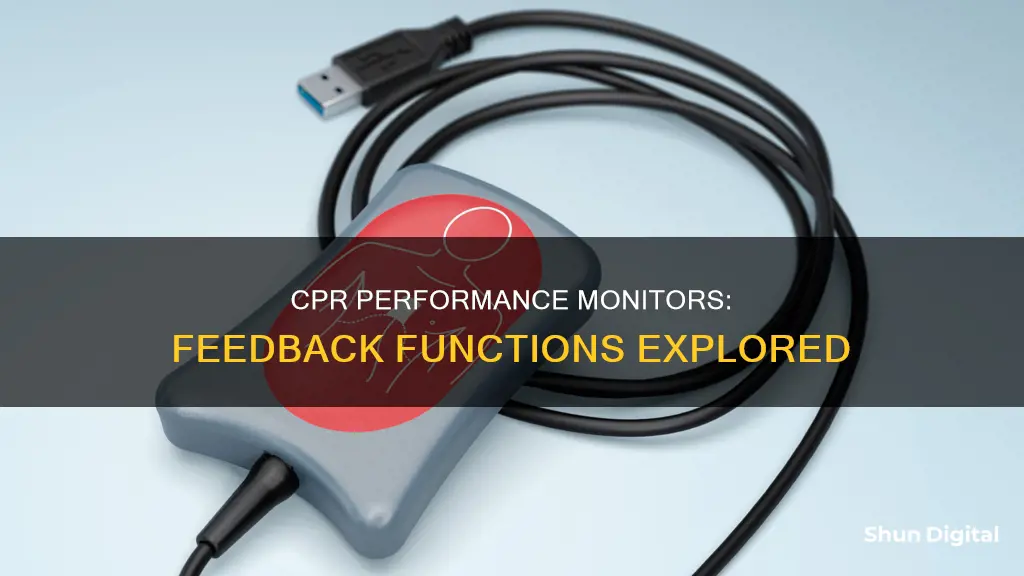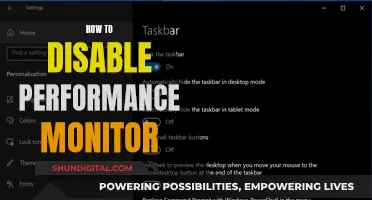
CPR performance monitors are innovative tools that provide real-time feedback to rescuers during cardiopulmonary resuscitation (CPR). These devices are designed to improve the quality of CPR and enhance patient outcomes during cardiac arrest. Some of the key feedback functions of CPR performance monitors include monitoring and providing feedback on compression depth, compression rate, ventilation parameters, and chest recoil. They also offer audio and visual cues to guide rescuers in delivering optimal CPR. These monitors help ensure that chest compressions are administered with the correct depth, rate, and force, improving the chances of successful resuscitation.
| Characteristics | Values |
|---|---|
| Compression Depth | Optimal compression depth in adults is at least 2 inches, but no more than 2.4 inches. |
| Compression Rate | The ideal rate is generally 100-120 compressions per minute. |
| Release Feedback | Ensure the chest is allowed to fully recoil after each compression. |
| Rhythm Adjustment | N/A |
| Ventilation Guidance | N/A |
| Alerts for Hands-off Time | N/A |
| Hand Position | Ensure correct hand placement to deliver effective compressions directly over the heart. |
| Compression Fraction | Evaluate the proportion of time spent performing chest compressions during CPR. |
| Audio and Visual Cues | Provide real-time audio and visual cues to guide rescuers in delivering high-quality CPR. |
What You'll Learn

Compression depth
CPR performance monitors measure and display the depth of chest compressions, alerting the rescuer if they are too shallow or too deep. Shallow compressions may be ineffective in generating sufficient blood flow, while compressions that are too deep can cause rib fractures and internal injuries. Feedback on compression depth helps ensure that compressions are within the correct range to optimise blood circulation and improve the chances of survival.
The use of real-time visual feedback devices has been shown to improve the quality of chest compressions by providing rescuers with immediate feedback on their technique. This allows them to adjust the depth of compressions accordingly, ensuring they meet the recommended guidelines.
Additionally, the rescuer's physical strength can impact the compression depth achieved. Rescuers are encouraged to use their upper body weight and leverage to achieve the recommended depth, especially when dealing with individuals with larger body types, as more force may be required.
Overall, maintaining the proper compression depth is crucial in CPR as it directly influences the effectiveness of the procedure and can significantly impact patient outcomes.
How Multiple Monitors Affect GPU Performance
You may want to see also

Compression rate
Maintaining the correct compression rate during CPR is critical to optimising blood flow and improving the chances of successful resuscitation. The recommended compression rate for adults is 100-120 compressions per minute. CPR performance monitors provide real-time feedback on the rate of chest compressions, helping rescuers stay within this recommended range.
Benefits of Real-Time Feedback
The use of real-time feedback technology significantly improves the quality of chest compressions. Without feedback, there is a tendency for compressions to be too shallow and too fast. By providing immediate feedback on compression rate, rescuers can adjust their technique and optimise blood circulation, thereby improving patient outcomes during cardiac arrest.
CPR performance monitors track the rate of chest compressions and provide audio and/or visual cues to guide rescuers. These cues may include prompts to adjust the rate if compressions are being delivered too fast or too slow. This helps rescuers maintain the recommended compression rate of 100-120 compressions per minute, ensuring that chest compressions are effective in circulating blood and improving the chances of resuscitation success.
The compression rate plays a crucial role in effective CPR. During cardiac arrest, the heart is unable to pump blood effectively, and chest compressions serve as a substitute for the heart's pumping action. The compression rate should be fast enough to create sufficient pressure to pump blood while also allowing enough time for the heart to refill between compressions.
The rate of chest compressions directly impacts blood flow during CPR. A compression rate that is too slow may not generate enough pressure to circulate blood effectively, while a rate that is too fast may not allow sufficient time for the heart to refill between compressions. Therefore, maintaining the recommended compression rate of 100-120 compressions per minute helps optimise blood flow and improve the chances of successful resuscitation.
Eco Mode on ASUS Monitors: What You Need to Know
You may want to see also

Ventilation parameters
In addition to chest compressions, proper ventilation is essential during CPR and can be monitored by CPR performance monitors. These devices can provide feedback on ventilation parameters such as the volume and rate of breaths delivered, ensuring that adequate oxygenation and ventilation are provided to the patient. This is crucial for maintaining blood circulation and increasing the chances of oxygen delivery to vital organs, especially the brain.
CPR feedback devices offer real-time monitoring of ventilation rate, ensuring ventilations are delivered at the appropriate frequency. This is an important aspect of CPR as it helps maintain a high compression fraction, which is the percentage of time during CPR that chest compressions are being performed, and is essential for effective circulation.
Additionally, these devices can guide rescuers to provide breaths at the recommended volume. This is crucial as it ensures that the patient's lungs receive enough air, optimising oxygenation and ventilation. The feedback on ventilation parameters helps prevent under or over-ventilation, both of which can be detrimental to the patient's health.
CPR performance monitors often include visual displays and audible cues to guide healthcare providers. For example, a metronome-like audio feature can guide rescuers to achieve the recommended compression rate, while LED lights or display screens can provide real-time visual feedback on ventilation parameters, allowing rescuers to adjust their technique accordingly.
By providing feedback on ventilation parameters, CPR performance monitors enhance the quality and effectiveness of CPR, ultimately improving patient outcomes during cardiac arrest.
Ultrawide Monitors: Performance Enhancers or Distracting Disadvantage?
You may want to see also

Real-time feedback and audio/visual cues
CPR performance monitors provide real-time feedback and audio/visual cues to guide healthcare providers in delivering high-quality CPR. These monitors are crucial in providing feedback on CPR performance and helping rescuers optimise their technique, ultimately improving patient outcomes.
Visual displays and audible cues are essential components of CPR performance monitors, offering prompts to adjust compression depth, rate, ventilation parameters, and hand position. This ensures that chest compressions and ventilation are delivered effectively and within recommended guidelines. For instance, a metronome-like audio feature guides rescuers to achieve the recommended compression rate of 100-120 compressions per minute, while LED lights or display screens provide real-time visual feedback on compression depth and rate.
The feedback functions of CPR performance monitors are designed to enhance the quality and effectiveness of CPR by providing real-time guidance. They play a crucial role in improving the chances of successful resuscitation and patient survival, especially when used by healthcare professionals, first responders, or laypersons.
In addition to the audio and visual cues, CPR performance monitors may also provide textual information or use colours to indicate whether the rescuer is adhering to the recommended guidelines. For example, a red flag may appear on the display to warn that the rate or depth of compressions is off-target. Alternatively, a visual diamond-shaped Perfusion Performance Index (PPI) may provide a comprehensive assessment of both depth and rate of compressions, indicating when chest compressions are optimal.
The feedback functions of CPR performance monitors empower rescuers to make real-time adjustments to their CPR technique, ensuring that patients receive the best possible care during cardiac arrest events.
Connecting Monitors to UCM204HD: A Step-by-Step Guide
You may want to see also

Rhythm adjustment
CPR performance monitors provide real-time feedback to help rescuers maintain this ideal rate. This feedback is crucial, as it allows rescuers to adjust their rhythm and speed to optimise blood flow and improve the chances of successful resuscitation.
The feedback functions on these devices often include audio and visual cues to guide rescuers. For example, a metronome-like audio feature can help rescuers maintain the correct rhythm and speed. Additionally, LED lights or display screens can provide visual feedback on compression rate, allowing rescuers to quickly adjust their technique.
These rhythm adjustment features are particularly useful during prolonged resuscitation efforts, where fatigue can impact the consistency and effectiveness of chest compressions over time. By providing continuous feedback, CPR performance monitors help ensure that chest compressions remain within the recommended rate range, even during extended periods of CPR.
In addition to real-time feedback, these devices can also be used as training tools. They can simulate resuscitation scenarios and provide feedback during CPR training sessions, helping individuals learn and improve their chest compression technique. This is especially beneficial for first responders and healthcare professionals, who can benefit from the guidance and confidence that these devices provide during high-pressure situations.
The ability to adjust rhythm and speed with the help of CPR performance monitors is a critical aspect of delivering high-quality and consistent CPR. By optimising chest compression rates, rescuers can improve blood circulation and enhance the chances of successful resuscitation, ultimately contributing to more positive patient outcomes.
Monitoring Internet Usage: A Guide for Modem Users
You may want to see also







